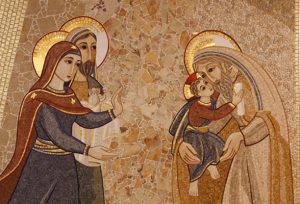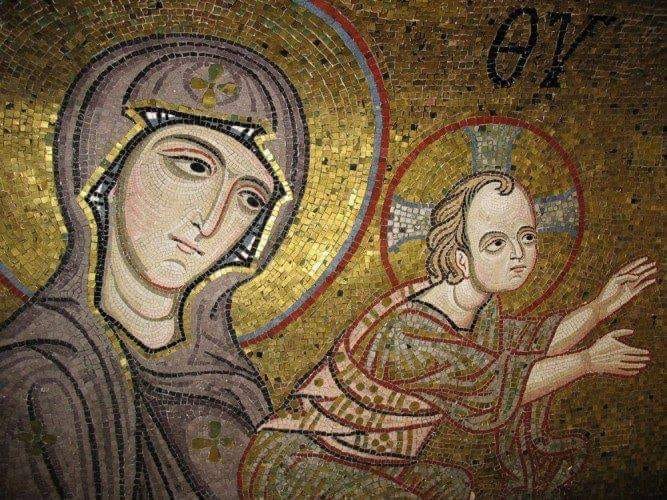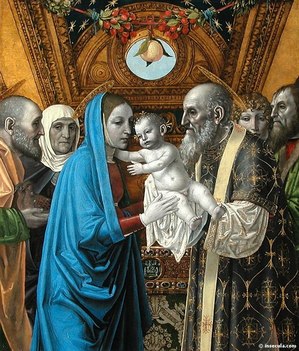Rejoice, O full of grace, Mother of God and Virgin, for from thee has risen the sun of righteousness, Christ our God, enlightening those who dwell in darkness. Rejoice you too, righteous watchman, that you have received in your arms the Redeemer of our souls, who also gives us the Resurrection.
Tag: Presentation of the Lord
Presentation of the Lord

Today’s feast brings to the end the Christmas cycle: 40 days ago we celebrated the Incarnation on Christmas Day. This feast has another name: the Byzantine Church calls it the Encounter of Our Lord. Western Catholics will call it Candlemas.
Why celebrate the Presentation of the Lord in the Temple? What impact does it have for us?
Look to Luke’s Gospel in which we see the honoring of the requirement of the Moasic Law for a mother’s purification forty days after giving birth. She comes to the Temple for prayer and re-incorporation into the community of faith. At this time child birth made the woman unclean to for a period of time. The Church uses the appearance of Joseph and Mary for these rituals to underline the paradox that God, author of the Law, here submits to the Law.
It is important to note that St. Luke records this particular observance of the Law. “The Church uses the appearance of Joseph and Mary for these rituals to underline the paradox that God, author of the Law, here submits to the Law.” Also biblically tied into the Temple visit was the recognition of Israel’s first-born sons who, when Egypt, were killed prior to the Exodus event; hence by tradition parents were bound to present an offering to claim their child.
Luke also reveals to us the prophetic utterance of Simeon and Anna who recognize and encounter the child Jesus as the glory of Israel, the light of revelation for all people. This encounter realizes the revelation of Jesus as the foretold Messiah — a fulfillment of an expectation.
Presentation of the Lord
The liturgical life of the Church is a prism which diffuses the blinding light of revelation into the variegated hues that we can perceive and whose colors gladden the hearts of the faithful. The metrical homily of Mar Jacob of Sarug on the Encounter of the Lord sheds light on why the righteous elder Simeon and the aged Anna the prophetess were chosen to greet the new-born Savior. “It was right too that one ancient in days should bear witness to the Elder Who became a Child at the end of the times.” The aged ones are a sign to us the Pre-eternal God-made-man has come at the end of time. In this context we recall the words of another Syriac father, Mar Isaac of Nineveh, “Life is given to us for repentance: let us not squander it in idle pursuits.”
h/t SMRC
Presentation of the Lord, Candlemas
We are 40 days away from the Nativity of the Lord. The Presentation of the Lord is a feast the Church in the Eastern part of the ecclesial world, known as an “Encounter,” a second epiphany of the new born King and Messiah given the words of the Simeon. Christ is identified as the Light of the Nations.
The Christology of the Liturgy is quite clear and instructive: by no other person is salvation possible. By the same token this Light to the Nations is a supreme sign of contradiction (St Cyril of Jerusalem) and a stumbling block (St Paul)
The feast began to observed in the 6th century. The Western Church made this feast more penitential because it began to be linked with the purification of Mary according to the Mosaic law.
In the Missal of Blessed John XXIII today ends the Christmas season whereas in the Missal of Paul VI the feast of the Baptism of the Lord ends Christmas.
Our liturgical observance of the Lord’s Presentation is also called “Candlemas” because the Church blesses candles, all the candles to be used in the Mass, including the Paschal Candle to be used at the Easter Vigil; home candles are also brought to church for this blessing. Besides the special prayers prayed, Simeon’s song Nunc dimittis, Saint John of Damascus’ song Adorna thalamum tuum, Sion AND Zacharia’s Benedictus are sung by the choir. Christ as the light of the world is not merely a theological statement, it is a reality in the life of the Christian. To what end do we reflect the light of Christ in the home, in the workplace, in social settings?
V. Zion, let your wedding chamber be prepared to receive Christ your King.
R. The Virgin conceived and gave birth to a son, yet she remained a virgin for ever. She knelt in worship before her child.
V. Simeon took the child in his arms and gave praise and thanks to God.
R. The Virgin conceived and gave birth to a son, yet she remained a virgin for ever. She knelt in worship before her child.
Ave, Mary full of grace
In whose virgin arms’ embrace
God to God Himself doth vow!
Alleluia, alleluia!
Let me in the temple wait,
Jesu, for mine all art Thou.
God is to His temple come;
Angels throng the hallowed dome;
What beyond hath heav’n in store?
Alleluia, alleluia!
God Himself our flesh doth wear;
This than heav’n itself is more.
Incense gales of gladness rise
Where this morning sacrifice
‘Mid re-echoing shouts is made.
Alleluia, alleluia!
Evening’s rite in tears shall end,
On the dark’ning Cross displayed.
There behold th’Oblation wrought,
By Whose precious ransom bought,
We are all to God made nigh.
Alleluia, alleluia!
Now no longer, Lord, our own,
Thine we live and Thine we die!
Let Thy servants now depart;
May we see Thee as Thou art,
Nought of earth arrest our eyes!
Alleluia, alleluia!
Let us here with Jesus grow,
And in Him hereafter rise!
A sequence from an 18th century Paris Missal
Consecrated Life is a living exegesis of the Word of God, Pope tells religious
In today’s feast we contemplate the Lord Jesus whom
Mary and Joseph take to the Temple “to present him to the Lord” (Luke
2:22). Revealed in this evangelical scene is the mystery of the Son of the
Virgin, the consecrated One of the Father, who came into the world to carry out
his will faithfully (cf. Hebrews 10:5-7).
Simeon points to him as “light
for revelation to the Gentiles” (Luke 2:32), and proclaims with prophetic
word his supreme offer to God and his final victory (cf. Luke 2:32-35). It is
the meeting of the two Testaments, the Old and the New. Jesus enters the
ancient Temple, He who is the new Temple of God: He comes to visit his people,
bringing to fulfillment obedience to the Law and inaugurating the end times of
salvation.
Continue reading Consecrated Life is a living exegesis of the Word of God, Pope tells religious
Presentation of the Lord
 In honor of the divine mystery that we celebrate
In honor of the divine mystery that we celebrate
today, let us all hasten to meet Christ. Everyone should be eager to join the procession
and to carry a light. Our lighted candle are a sign of the divine splendor of
the One who comes to expel the dark shadows of evil and to make the whole
universe radiant with the brilliance of His eternal light. Our candles show us
how bright our souls should be when we go to meet Christ.
Presentation of the Lord: Adorna, Sion, Thalamum
He comes, her Lord and her Betrothed.
Let bride and Bridegroom, by faith’s light,
A vigil keep throughout the night.
Saint Simeon, go forth in joy.
Exult to see the baby Boy:
Make known to all the Light divine
That soon on ev’ry land shall shine.
His parents to the temple bring
The Temple as an offering
The righteousness of law He chose
Though to the law He nothing owes.
So, Mary, bring this little one,
Yours and the Father’s only Son
Through whom our offering is made
By whom our ransom price is paid.
And forward, royal Virgin, go
And let rejoicing overflow
With gifts bring forth your newborn Son
Who comes to rescue everyone.
Lord Jesus Christ, the Glory bright
Who guides the nations into light
Be praised, and for eternity
Be glorified, O Trinity. Amen.
Text by
Presentation of the Lord: Candlemas
 Lord, now Thy servant depart in peace, according to Thy word; for my eyes have seen Thy salvation which Thou has prepared in the presence of all peoples, a light for revelation to the Gentiles, and for glory to Thy people Israel.
Lord, now Thy servant depart in peace, according to Thy word; for my eyes have seen Thy salvation which Thou has prepared in the presence of all peoples, a light for revelation to the Gentiles, and for glory to Thy people Israel.
Almighty and everlasting God, we humbly beseech Thy majesty, that as Thine only-begotten Son was this day presented in the temple in the substance of our flesh, so too Thou would grant us to be presented unto Thee with purified souls.
The blessings of candles, symbolic of Christ the Light to all peoples, is observed on this feast is a poignant reminder that the great feast of the Incarnation of our Lord and Savior means something as it fails to reduce God-becoming man to sentiment or ethics. Taken by the faithful to their homes, the blessed candles are a reminder that Jesus Christ is indeed “Light from Light, True God from True God.”
The Presentation of the Lord in the Temple emphasizes in yet a more radical way the manifestation of the Christ child at Epiphany celebrated a few weeks ago. This feast, like the Christmas-Epiphany cycle, proclaims Jesus as Lumen gentium (the Light of the world). He is the true foundation of our lives. At the singing of the Canticle of Simeon (see above) the Church puts on our lips the words of Scripture instructing us that Jesus is “The light for the revelation of the Gentiles: and for the glory of Thy people Israel.”
In a nutshell, the Church says of the observance of the feast of the Presentation:
The feast of February 2 still retains a popular character. It is necessary, however, that such should reflect the true Christian significance of the feast. It would not be proper for popular piety in its celebration of this feast to overlook its Christological significance and concentrate exclusively on its Marian aspects. The fact that this feast should be “considered […] a joint memorial of Son and Mother” would not support such an inversion. The candles kept by the faithful in their homes should be seen as a sign of Christ “the light of the world” and an expression of faith. (Directory on Popular Piety and the Liturgy, 123)



